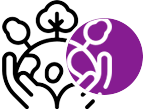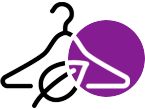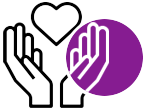
Making better choices: Here are the top tips to buy sustainably
Share
So you've read my blog about sustainable fabrics - giving you insight into what fabrics are sustainable and what fabrics are terrible for the environment.
And now what? You want to do the right thing but don't know where to start?
You've come to the right place.
In this blog I'll explore how you can start making better choices and what to look for when reading labels.
What does making better choices mean?
Buying less - new clothing take resources to produce and let's face it - just because we've bought it, doesn't mean we'll wear it. Dr. Jennifer Baumgartner, author of You are What you Wear, says that the majority of people wear 20% of their closet 80% of the time. We keep going back to what we know and what we're comfortable wearing. So, next time, think about whether your purchase will truly be worn and if so, what can it be paired with that's already existing in your wardrobe? If you're unable to answer that then, make the choice not to buy.
Sharing & swapping with friends - if you count all the outfits and single pieces of clothing that you and your group of friends own, there is no need to ever go shopping again! This option of sharing and swapping with friends is a great way to re-use what you and your friends already have and it's easy on the wallet. Have a swap clothes party and celebrate the occasion - the clothes that you are no longer fond of may find a new home.
Buying up-cycled and re-cycled clothing - If you have to make a purchase, the best purchase is to buy up-cycled and re-cycled goods. This choice helps to stop garments from going to landfill. According to a McKinsey & Company report, 100 billion articles of clothing are purchased worldwide and we know most of that will end up as waste.
Buying from brands who are doing the right thing by people, animals and the environment - this is the meaning of buying well. Research brands and fabrics. Not all fabrics are created equal. There are some which have significantly worse impact than others. It is about taking the time to understand what you're purchasing and who you're supporting. Look at company websites, look at reviews and even reach out to the company to find out more information. Yes, this all takes time but isn't our planet worth it?
You vote with your wallet. Every dollar you spend supporting sustainable brands sends your vote to change how we consume, what we consume and how often we consume
Top certifications to look for on labels
Getting savvy with reading labels will help you to shop sustainably. Below are some common labels and their meaning.
GOTS - Global Organic Textile Standard and this certification is provided to textiles that contain at least 70% organic material. The certification happens at various stages of the supply chain so you can be assured that when a label has a GOTS symbol, the material and the finished product has passed the criteria from farm to store.
Fair trade International - this label is perhaps the most recognised and trusted sustainability label in the world. This certification identifies brands that provide safe and fair working conditions for their workers, protect the ecosystem, and support community development. It ensures that farmers and growers earn a living wage and achieve sustainable and equitable trade relations.
Peta-approved Vegan - this label is used to identify products free from animal ingredients and any form of cruelty towards animals. When buying this label you can shop cruelty free with confidence.
Why didn't BCI make the list above?
BCI stands for Better Cotton Initiative and the label is seen throughout popular stores such as Target and K-Mart. The Better Cotton Initiative is a non-profit, multi-stakeholder governance group that promotes better standards in cotton farming and practices across 21 countries. It exists to make global cotton production better for the people who produce it, better for the environment it grows in and better for the sector’s future.
So why didn't the BCI label make the Top Certifications list above?
BCI is driven by 7 guiding principles:
- Farmers should minimise the harmful impact of crop protection practices
- They should promote water stewardship
- They should care for the health of the soil
- BCI Farmers should enhance biodiversity and use land responsibly
- They should care for and preserve fibre quality
- They should promote decent work
- And BCI Farmers should operate an effective management system
And herein lies the problem. All of their principles are non-binding through the use of the word "should". Farmers are not held to stringent criteria so you don't know how sustainably BCI cotton has been produced.
In 2018, the Changing Markets Foundation produced a report concluding that BCI has undermined the best cotton production in that of organic cotton. Brands are preferring BCI as it is cheaper and therefore farmers have switched from organic cotton to BCI cotton. The report went further and stated that of all the textile certification schemes, BCI is the worst.
Important Note
Not all small and up-coming brands can afford formal certifcation so look for labels that state how much of their end product has been made with organic or recycled material. Pay close attention to their website and read whether their brand pays a living wage to workers. Always read reviews and see what content is being posted on their socials - is it congruent with what they're claiming on their website and in their advertising? Don't be afraid to reach out and enquire directly with the brand.
Being a small brand myself, I love customer enquires - I get a buzz out of knowing there are people that care enough to make contact and want to find out more.
In Conclusion
Making better choices means:
- Buying Less
- Sharing & Swapping with friends
- Buying up-cycled or re-cycled
- Buy from brands who are doing the right thing
Top Certifications to look for on labels
- GOTS
- Fair Trade International
- Peta-approved Vegan
Why BCI didn't make the list?
BCI doesn't have a strict criteria that farmers must meet to obtain the certification. BCI has been favoured by brands because it is cheaper and this has resulted in farmers switching from Organic Cotton farming to BCI. Furthermore, a report by the Changing Markets Foundation stated that of all the textile certification schemes, BCI is the worst.
Important Note
Not all small brands can afford formal certifications so look for labels that state how much of their finished product is made from organic or re-cycled materials. Always look for information on their website and don't be afraid to reach out directly and ask questions. Support small brands but do your research first.








